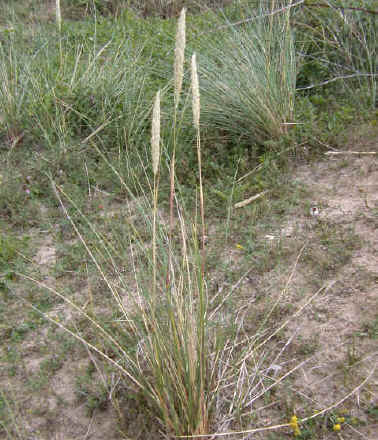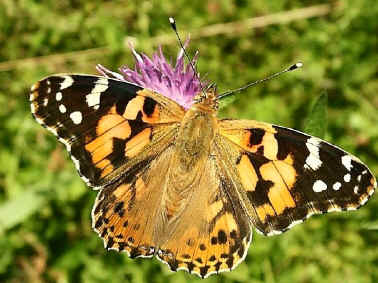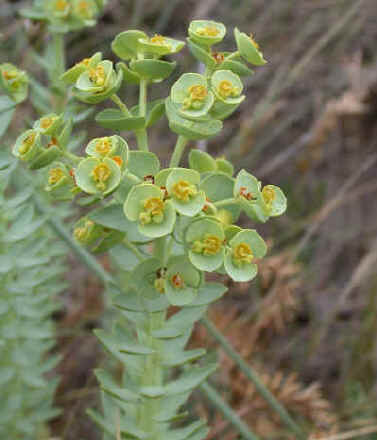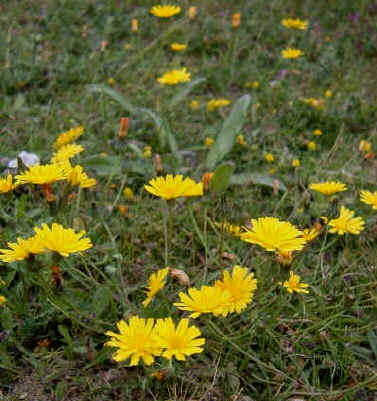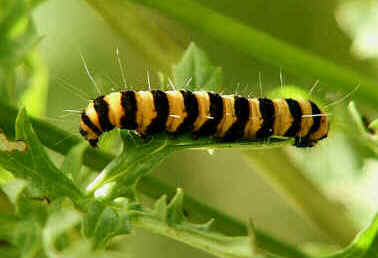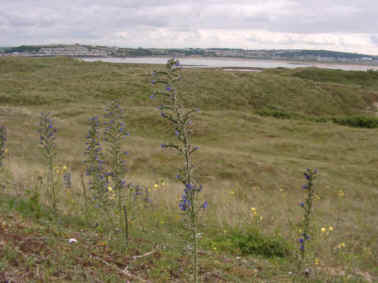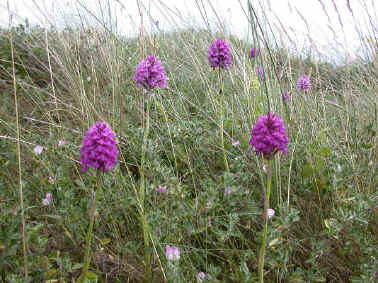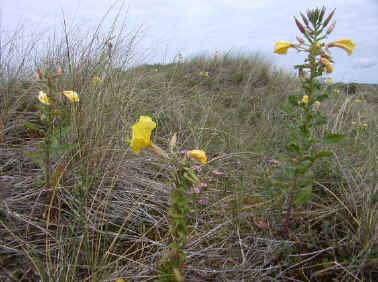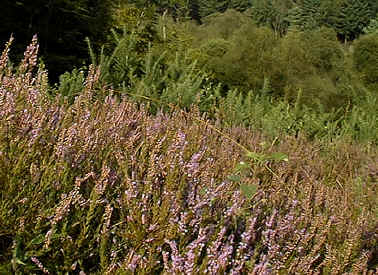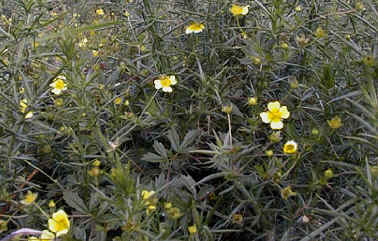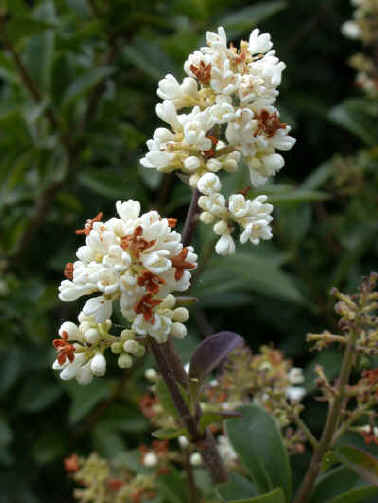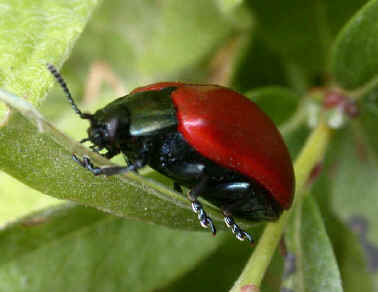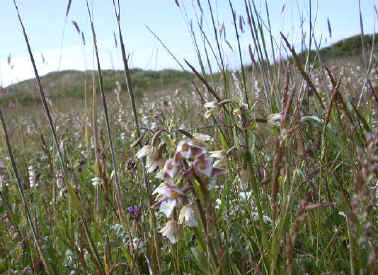| Coastal Sand Dunes |
Scroll sideways to follow the dune succession.
Scroll down under each successional stage for information and pictures of species likely to be present at that stage. |
|
 |
|||||||||||
 |
 |
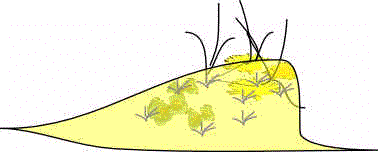 |
 |
**
See note
|
 |
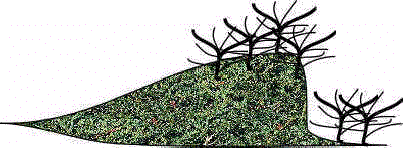 |
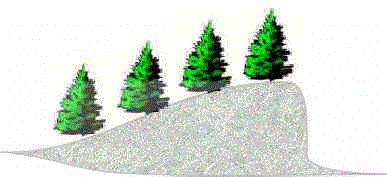 |
|||||||
| Dune Building | Pioneer Stage - Foredunes | Yellow (White) Dune Stage | Grey Dune Stage - Calcareous | Grey Dune Stage - Acidic | Dune Scrub Stage | Conifer Plantations | ||||||||
Plants growing at the back of the beach, together with flotsam and jetsam dropped at the high tide mark, cause the wind speed to drop locally. Sand being carried by the wind drops out at these points and begins to build small sand piles. This now forms another more substantial wind break, which encourages more and more sand to be deposited. The sand dune is beginning to build. Depending on wind speed, the dune will either gradually move inland (high wind speeds), or it will remain static. If there is a good supply of sand, new dunes may form to seaward. |
Pioneer Plants Sand Couch-grass and Lyme-grass, Elymus arenarius, are pioneer species on newly forming dunes. They are very tolerant of salt and can therefore grow much closer to the sea than most other grasses. Both species have a waxy coating on the leaves which enables them to retain water. The leaves are often rolled, which is another adaptation which reduces the leaf surface area exposed to the atmosphere. This decreases the plant transpiration rates. These will be some of the first plants to begin to stabilize new dunes with their networks of root systems. By helping to bind the sand in one place, they produce a more stable wind break, encouraging yet more sand to be deposited and building the dune still higher. However, as the amount of sand being deposited increases, these pioneer plants cannot grow quickly enough to avoid being smothered. Where the rate of sand deposition is greater than 30cm per year, they will be outcompeted by Marram Grass. Marram Grass then takes over the process of binding the dunes. This species is less tolerant of exposure to sea water and therefore occurs slightly further away from the sea than the first pioneer species. Its growth can keep pace with sand being deposited at a rate of up to 1 metre per year. Each plant can also spread sideways by up to 3 metres a year, helping to trap the sand and keep it in one place. Marram Grass, Ammophila arenaria
Painted Lady Butterfly Cynthia cardui
Dunes can sometimes be covered in migrating insects, such as Painted Lady butterflies, Silver Y moths or ladybirds which have been helped along by winds blowing across the English Channel.
|
Marram
Grass Marram Grass stabilizes the sand some distance below the surface because of its deep vertical root system and extensive horizontal root network. The clumps of Marram Grass are continually buried, only to regrow up through the newly deposited sand. Under dry atmospheric conditions, the leaves of Marram Grass will roll up tightly, exposing only the tough outer waxy cuticle of the leaf. This reduces transpiration and water loss. These later plant pioneers are more efficient at binding the surface sand, both because of the cover they provide and because of their near surface horizontal network of roots. They include Sand Sedge (Carex arenaria), Sea Holly (Eryngium maritimum) and Sea Bindweed (Calystegia soldanella).Spurges, such as Sea Spurge, Euphorbia paralias, and Portland Spurge, will colonize the hotter, drier slopes of the dunes. They have fleshy, waxy leaves with a high capacity for water storage. The leaves and stems also contain a white latex which makes them taste unpleasant to herbivores such as rabbits. Portland Spurge Euphorbia portlandica
This stage is called the yellow (or white) dune stage, because the plant cover is patchy and clean yellow or white sand can still be clearly seen over large areas. Rabbits, Oryctolagus cuniculus, are common on the dunes because the sand is easy to burrow into.
Where there are large populations of rabbits, the vegetation may become so heavily cropped by the rabbits, that it forms a very short, tight turf. Many of the herbaceous plants become miniature or stunted. Decomposition of the rabbit droppings begins to add a small amount of nutrients to the nutrient-poor sand. Other plants, typical of waste ground in general, will also rapidly colonize bare patches on the dunes. These will mostly be plants with wind-blown parachute seeds (Family Compositae), which are able to grow very rapidly, produce flowers and set seed. This includes plants such dandelions, groundsels, thistles, hawkbits, hawkweeds, hawks-beards and ragworts. Mouse-ear Hawkweed Hieracium pilosella
Butterflies and moths will now be found, searching for nectar among the composite flowers, while the caterpillars of some species may feed directly on the plants. Cinnabar Moth Caterpillar Tyria jacobaea
Some humus begins to build up in the sand from dead pioneer plant species. This helps to hold a little water in the surface layers and provides a few more nutrients. These additions allow seeds of winter annual flowering plants to germinate in the autumn, pass the winter as a seedling, followed by rapid growth and flowering in the spring. They therefore produce seeds and complete their lifecycle before the hotter, drier conditions in the summer evaporate the small store of water held in the dune surface. The seeds will lie dormant through the hot summer months, germinating in the following autumn as water supplies increase. Winter Annual species include: Common Whitlow-grass Early Forget-me-not |
The dunes by now have a more or less continuous plant cover, effectively anchoring the dune sand in one place. Where a series of dunes has formed at the back of the beach, this stage will be on the dunes further inland. In colder autumn and winter months much of the available water will come from dew being deposited at night. Developing humus layers from decaying vegetation will help to retain some of the moisture. Water will still be scarce in hot summer months. As sand stops being deposited, Marram Grass will die out. Grey-green lichens (Peltigera, Cladonia) will colonize the dune extensively, combining with accumulating humus to give the dune sand a characteristic dirty grey colour. Mosses such as Bryum and Sand-dune Screw-moss, Tortula ruraliformis, also colonize the dunes. The lichens and mosses become dry, hard and dormant when water is in short supply, but as soon as it becomes available, they start to grow again. In high summer, the dried lichens and mosses give the dunes a very crunchy texture, which is almost like walking on crisps. Where there are large quantities of pulverized sea shells included in the dune sand, plants which thrive in lime-rich areas will become established. Viper's-bugloss Echium vulgare
Pyramidal Orchid
Other typical Grey-dune plants include waste ground species with a preference for land close to the sea. Evening-primroses Oenanthera sp.
By this stage, a wide variety of invertebrates will also be living on the dunes. Carpets of Wild Thyme may develop, giving off a heady scent when crushed. Small Skipper Thymelicus
flavus
Other common animals on grey dunes include grasshoppers, caterpillars, bees, plant bugs and spiders. Skylarks, Alauda arvensis, may be heard singing high above the dunes, while Kestrels, Falco tinnunculus, hunt voles and wood mice among the dune turf.
|
*Where the dune sand consists purely of quartz grains, without pulverized shell material, the developing soil substrate will be acidic. The Marram Grass stage will progress straight to the acidic grey dune stage. **Older grey dunes, which have previously been calcareous, may also become increasingly acidic as rainwater progressively leaches out the nutrients, leading into an acidic grey dune stage. Equally, calcareous grey dunes may just progress straight to the Dune Scrub stage. On these dunes, plants characteristic of acidic grasslands will be found and dune heaths, dominated by gorse (Ulex), Bracken (Pteridium aquilinum) and Heather may develop. Heather (Calluna vulgaris)
Tormentil Potentilla erecta
Wood Sage Teucrium scorodonia
|
The build-up of humus from all the decaying vegetation of previous stages, means that the sand has by now developed into a poor sandy soil, capable of supporting pasture grasses and bushes. Bushes will develop on the tops and in the hollows of the dunes. These will include species such as Hawthorn, Crataegus monogyna, Elder, Sambucus, Brambles, Rubus and Sea Buckthorn Hippophae rhamnoides. Sea Buckthorn has often been introduced onto dunes to help stabilize them. It has nitrogen fixing root nodules and so can thrive even on nutrient-poor young dunes. However, it can become an exceptionally invasive problem. It spreads via seeds and suckers and can form impenetrable spiny thickets, excluding most other vegetation. Privet is another common species at this stage of dune development. Privet Ligustrum vulgare
As scrub develops, shorter vegetation will begin to be shaded out underneath. The hollows between the dunes are known as 'slacks'. They are often wet for much of the year because they are closer to the underlying water table than the tops of the dunes. They usually develop a very characteristic vegetation.
Dune slacks may be colonized by Creeping Willow, a low-growing, straggling bush. Large populations of jewel-bright, red leaf beetles may be found feeding on the willow in the summer. Poplar Leaf Beetle Chrysomela populi
Growing amongst and alongside the prostrate willow stems, may be grasses and a variety of herbaceous plants, including orchids, such as Marsh Helleborine. In summer, large expanses of Marsh Helleborine in flower provide a wonderful sight. Marsh Helleborine Epipactis palustris
(Continued at top of page.) |
The final stage in dune stabilization is often achieved by planting conifers, such as Corsican Pine, which is very tolerant of salt. Even in the absence of tree planting, the dunes will eventually develop into woodland.
Continue to
For more images and information on dunes see
|
||||||||


